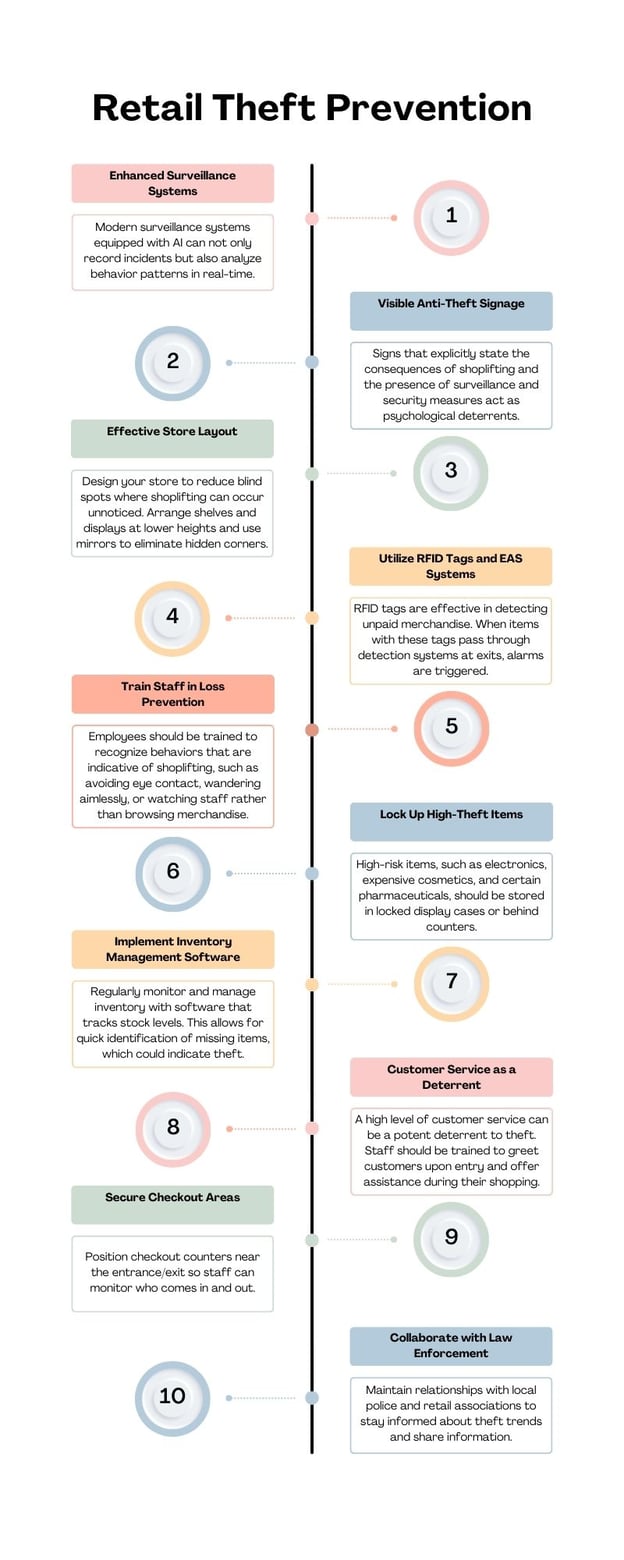In an era where retail theft is evolving into a sophisticated challenge, businesses across America are facing an unprecedented surge in shoplifting and organized retail crime (ORC). These shifts are not only impacting the bottom line of businesses but also altering the shopping experience for consumers nationwide.
Amidst this challenging environment, advancements in technology, particularly in artificial intelligence (AI), are offering new hope. Major retailers like Walmart, Target, and Kroger are partnering with tech firms to deploy cutting-edge solutions, including AI-powered surveillance systems, facial recognition, and smart anti-theft devices. These innovations aim not just to catch thieves but to deter criminal activities before they occur, striking a balance between effective loss prevention and maintaining a positive customer experience.
This article delves into the current state of retail theft, the innovative technologies being harnessed to combat it, and practical strategies businesses can implement. We will explore how retailers can protect their assets and ensure safety without compromising on customer service, offering an insightful guide to navigating the complex landscape of modern retail theft prevention.
Understanding Retail Theft: An Overview
Retail theft, a persistent challenge for businesses of all sizes, has escalated both in scale and complexity in recent years. This multi-faceted issue encompasses everything from opportunistic shoplifting to highly coordinated organized retail crime (ORC), impacting not just the profitability of businesses but also the broader economic and social fabric.
.jpg?width=1200&height=797&name=retail-theft%20(1).jpg)
The Changing Face of Retail Theft
Recent trends indicate a marked shift in the nature of retail theft. While traditional shoplifting persists, there is a rising tide of organized retail crime. These sophisticated operations often involve groups of professional thieves who orchestrate large-scale thefts to resell merchandise, affecting businesses from local boutiques to national chains. The National Retail Federation (NRF) has noted a substantial increase in such incidents, highlighting the evolving challenge retailers face.
The Economic Impact
The financial repercussions of retail theft are significant. The NRF estimates that organized retail crime alone costs companies an average of 7 cents for every $100 in sales. This loss is not just a matter of lost merchandise but also encompasses additional expenses in security measures, loss prevention strategies, and potential store closures.
Technological Advancements in Prevention
In response to these challenges, retailers are increasingly turning to technology. Advanced systems incorporating AI, video surveillance, facial recognition, and RFID tags are being deployed to not only detect but also prevent theft. These technologies are revolutionizing how retailers approach loss prevention, offering more sophisticated and proactive solutions.
The Balance between Security and Experience
While implementing robust anti-theft measures is crucial, retailers must also consider the impact on the customer experience. Overly stringent security measures can deter legitimate customers and negatively affect sales. Finding the right balance is key to ensuring both the safety of assets and the satisfaction of customers.
Difference between Retail Theft and Shoplifting
Two terms often used interchangeably but distinct in nature are 'retail theft' and 'shoplifting'. While both impact the retail sector, their scope and implications vary significantly.
Shoplifting: The Individual Act
Shoplifting is typically defined as the act of stealing goods from a retail establishment. It is often an opportunistic crime, committed by individuals acting alone. Shoplifting can range from small, impulsive thefts — like pocketing a cosmetic item — to more premeditated acts involving the concealment of higher-value goods. Despite its seemingly minor scale in individual instances, shoplifting accumulates substantial losses for retailers over time.
Key Characteristics:
- Often impulsive or opportunistic.
- Usually involves individuals or small groups.
- Targets a wide range of products, often of lower value.
- Less organized and more random in nature.
Organized Retail Theft: A Coordinated Effort
Organized Retail Crime (ORC) refers to professional theft rings that steal merchandise from retailers to resell, return for profit, or use in other criminal enterprises. ORC is methodical, sophisticated, and often involves a network of individuals coordinating their efforts. These crimes can range from coordinated shoplifting in stores to elaborate schemes involving cargo theft and distribution center burglaries.
Key Characteristics:
- Highly organized and premeditated.
- Involves a network of individuals, often part of larger criminal operations.
- Targets specific goods, often high-value or easily resold items.
- Can involve complex schemes, including cargo theft and fraud.
- Economic and Social Impact
The economic impact of ORC is significantly higher than individual shoplifting cases. Organized thefts can result in massive losses in a single incident, affecting not only retailers' profits but also leading to increased prices for consumers and potential job losses. ORC also has broader social implications, as it is often connected to larger criminal networks and can fund other illicit activities.
How to Prevent Theft in Retail Stores?

Enhanced Surveillance Systems
Modern surveillance systems equipped with AI can not only record incidents but also analyze behavior patterns in real-time. These systems can identify suspicious activities, like loitering in certain areas, or actions that are commonly associated with shoplifting. The presence of cameras itself is a deterrent, and the ability to provide clear footage can aid in legal proceedings if theft occurs.
Visible Anti-Theft Signage
Signs that explicitly state the consequences of shoplifting and the presence of surveillance and security measures act as psychological deterrents. They should be prominently displayed at entry points, near high-value items, and in areas prone to shoplifting.
Effective Store Layout
Design your store to reduce blind spots where shoplifting can occur unnoticed. Arrange shelves and displays at lower heights and use mirrors to eliminate hidden corners. Place high-value items in central, well-trafficked areas and near the checkout counters.
Utilize RFID Tags and EAS Systems
RFID tags and EAS systems are effective in automatically detecting unpaid merchandise. When items with these tags pass through detection systems at exits, alarms are triggered, alerting staff. These tags are especially useful for high-value items and can be deactivated at the checkout upon purchase.
Train Staff in Loss Prevention
Employees should be trained to recognize behaviors that are indicative of shoplifting, such as avoiding eye contact, wandering aimlessly, or watching staff rather than browsing merchandise. They should also be trained in how to approach and interact with potential shoplifters and when to involve security or law enforcement.
Lock Up High-Theft Items
High-risk items, such as electronics, expensive cosmetics, and certain pharmaceuticals, should be stored in locked display cases or behind counters. This requires customers to interact with an employee to access these items, significantly reducing the opportunity for theft.
Implement Inventory Management Software
Regularly monitor and manage inventory with software that tracks stock levels. This allows for quick identification of missing items, which could indicate theft. Regular stock checks and audits should be performed to maintain accuracy.
Customer Service as a Deterrent
A high level of customer service can be a potent deterrent to theft. Staff should be trained to greet customers upon entry and offer assistance during their shopping. This friendly but watchful presence can dissuade potential shoplifters.
Secure Checkout Areas
Position checkout counters near the entrance/exit so staff can monitor who comes in and out. Design the area to funnel customers past the cash registers, reducing the chance of someone leaving with unpaid merchandise. Using entry and exit gates can also help control customer flow.
Collaborate with Law Enforcement and Retail Associations
Maintain relationships with local police and retail associations to stay informed about theft trends and share information. Participating in or forming retailer coalitions can be effective for sharing strategies, alerting neighboring businesses about known thieves, and collaborating on community-wide loss prevention efforts.
Conclusion: Fortifying Retail Against Theft
As the retail landscape continues to evolve, so does the challenge of retail theft. From the opportunistic shoplifter to the sophisticated rings of organized retail crime, the threat to businesses is multifaceted and ever-changing. However, the array of strategies and technologies available to retailers today provides a robust toolkit for combating these challenges.
Employing enhanced surveillance systems, creating effective store layouts, and utilizing advanced technologies like RFID tags are just the beginning. Crucially, the human element — through trained staff and attentive customer service — plays a pivotal role in deterring theft. Moreover, the collaboration between retailers, technology providers, and law enforcement creates a united front against retail crime.
Yet, in our quest to secure our stores, we must balance security with the shopping experience. Overly stringent measures may protect merchandise but can also alienate the customer base. The goal is to create an environment where customers feel welcome and safe, and where theft is systematically deterred through a combination of technology, strategy, and human vigilance.



